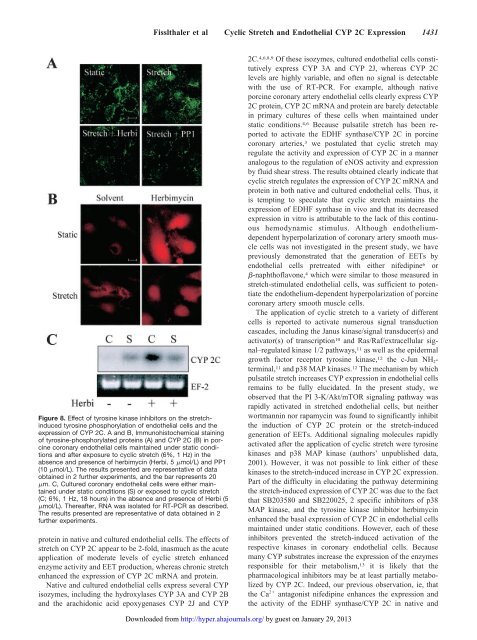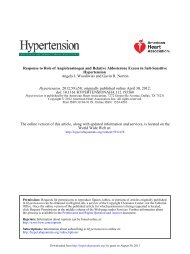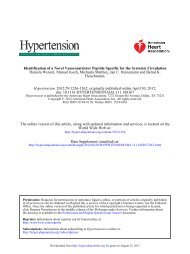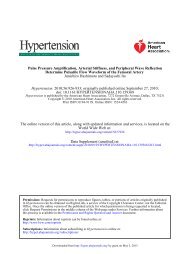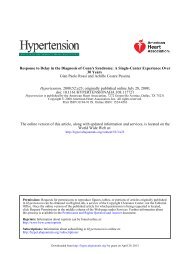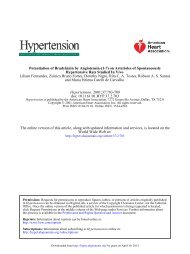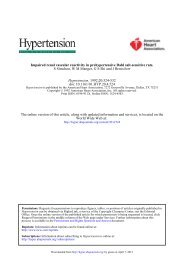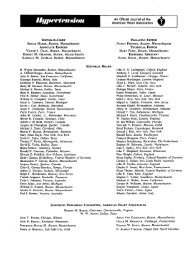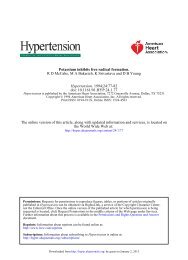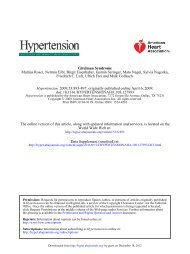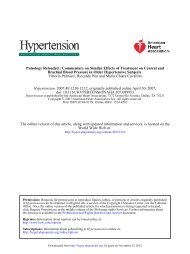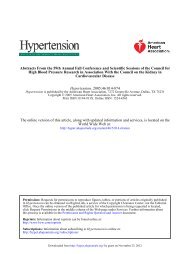Busse Beate Fisslthaler, Rüdiger Popp, U. Ruth ... - Hypertension
Busse Beate Fisslthaler, Rüdiger Popp, U. Ruth ... - Hypertension
Busse Beate Fisslthaler, Rüdiger Popp, U. Ruth ... - Hypertension
You also want an ePaper? Increase the reach of your titles
YUMPU automatically turns print PDFs into web optimized ePapers that Google loves.
Figure 8. Effect of tyrosine kinase inhibitors on the stretchinduced<br />
tyrosine phosphorylation of endothelial cells and the<br />
expression of CYP 2C. A and B, Immunohistochemical staining<br />
of tyrosine-phosphorylated proteins (A) and CYP 2C (B) in porcine<br />
coronary endothelial cells maintained under static conditions<br />
and after exposure to cyclic stretch (6%, 1 Hz) in the<br />
absence and presence of herbimycin (Herbi, 5 �mol/L) and PP1<br />
(10 �mol/L). The results presented are representative of data<br />
obtained in 2 further experiments, and the bar represents 20<br />
�m. C, Cultured coronary endothelial cells were either maintained<br />
under static conditions (S) or exposed to cyclic stretch<br />
(C; 6%, 1 Hz, 18 hours) in the absence and presence of Herbi (5<br />
�mol/L). Thereafter, RNA was isolated for RT-PCR as described.<br />
The results presented are representative of data obtained in 2<br />
further experiments.<br />
protein in native and cultured endothelial cells. The effects of<br />
stretch on CYP 2C appear to be 2-fold, inasmuch as the acute<br />
application of moderate levels of cyclic stretch enhanced<br />
enzyme activity and EET production, whereas chronic stretch<br />
enhanced the expression of CYP 2C mRNA and protein.<br />
Native and cultured endothelial cells express several CYP<br />
isozymes, including the hydroxylases CYP 3A and CYP 2B<br />
and the arachidonic acid epoxygenases CYP 2J and CYP<br />
<strong>Fisslthaler</strong> et al Cyclic Stretch and Endothelial CYP 2C Expression 1431<br />
2C. 4,6,8,9 Of these isozymes, cultured endothelial cells constitutively<br />
express CYP 3A and CYP 2J, whereas CYP 2C<br />
levels are highly variable, and often no signal is detectable<br />
with the use of RT-PCR. For example, although native<br />
porcine coronary artery endothelial cells clearly express CYP<br />
2C protein, CYP 2C mRNA and protein are barely detectable<br />
in primary cultures of these cells when maintained under<br />
static conditions. 4,6 Because pulsatile stretch has been reported<br />
to activate the EDHF synthase/CYP 2C in porcine<br />
coronary arteries, 3 we postulated that cyclic stretch may<br />
regulate the activity and expression of CYP 2C in a manner<br />
analogous to the regulation of eNOS activity and expression<br />
by fluid shear stress. The results obtained clearly indicate that<br />
cyclic stretch regulates the expression of CYP 2C mRNA and<br />
protein in both native and cultured endothelial cells. Thus, it<br />
is tempting to speculate that cyclic stretch maintains the<br />
expression of EDHF synthase in vivo and that its decreased<br />
expression in vitro is attributable to the lack of this continuous<br />
hemodynamic stimulus. Although endotheliumdependent<br />
hyperpolarization of coronary artery smooth muscle<br />
cells was not investigated in the present study, we have<br />
previously demonstrated that the generation of EETs by<br />
endothelial cells pretreated with either nifedipine 6 or<br />
�-naphthoflavone, 4 which were similar to those measured in<br />
stretch-stimulated endothelial cells, was sufficient to potentiate<br />
the endothelium-dependent hyperpolarization of porcine<br />
coronary artery smooth muscle cells.<br />
The application of cyclic stretch to a variety of different<br />
cells is reported to activate numerous signal transduction<br />
cascades, including the Janus kinase/signal transducer(s) and<br />
activator(s) of transcription 10 and Ras/Raf/extracellular signal–regulated<br />
kinase 1/2 pathways, 11 as well as the epidermal<br />
growth factor receptor tyrosine kinase, 12 the c-Jun NH 2terminal,<br />
11 and p38 MAP kinases. 12 The mechanism by which<br />
pulsatile stretch increases CYP expression in endothelial cells<br />
remains to be fully elucidated. In the present study, we<br />
observed that the PI 3-K/Akt/mTOR signaling pathway was<br />
rapidly activated in stretched endothelial cells, but neither<br />
wortmannin nor rapamycin was found to significantly inhibit<br />
the induction of CYP 2C protein or the stretch-induced<br />
generation of EETs. Additional signaling molecules rapidly<br />
activated after the application of cyclic stretch were tyrosine<br />
kinases and p38 MAP kinase (authors’ unpublished data,<br />
2001). However, it was not possible to link either of these<br />
kinases to the stretch-induced increase in CYP 2C expression.<br />
Part of the difficulty in elucidating the pathway determining<br />
the stretch-induced expression of CYP 2C was due to the fact<br />
that SB203580 and SB220025, 2 specific inhibitors of p38<br />
MAP kinase, and the tyrosine kinase inhibitor herbimycin<br />
enhanced the basal expression of CYP 2C in endothelial cells<br />
maintained under static conditions. However, each of these<br />
inhibitors prevented the stretch-induced activation of the<br />
respective kinases in coronary endothelial cells. Because<br />
many CYP substrates increase the expression of the enzymes<br />
responsible for their metabolism, 13 it is likely that the<br />
pharmacological inhibitors may be at least partially metabolized<br />
by CYP 2C. Indeed, our previous observation, ie, that<br />
the Ca 2� antagonist nifedipine enhances the expression and<br />
the activity of the EDHF synthase/CYP 2C in native and<br />
Downloaded from<br />
http://hyper.ahajournals.org/ by guest on January 29, 2013


